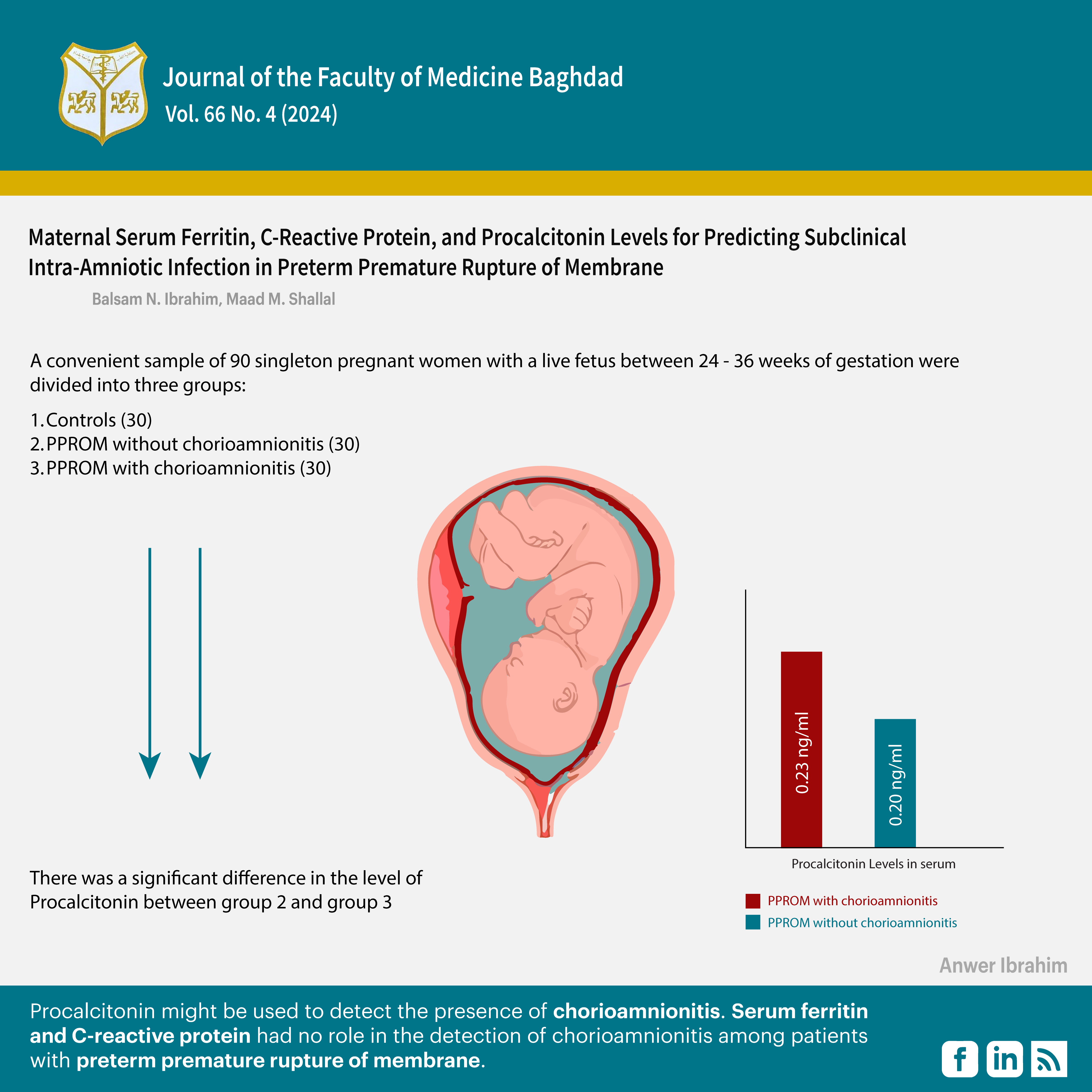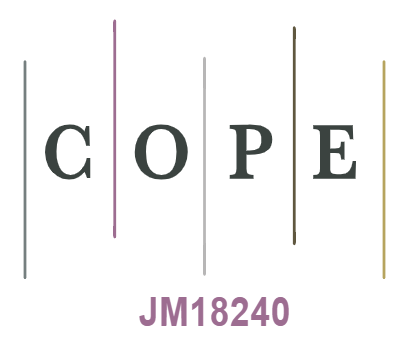Maternal Serum Ferritin, C-Reactive Protein, and Procalcitonin Levels for Predicting Subclinical Intra-Amniotic Infection in Preterm Premature Rupture of Membrane
DOI:
https://doi.org/10.32007/jfacmedbagdad.6621997Keywords:
C-reactive protein, Chorioamnionitis, Preterm premature rupture of membrane, Procalcitonin, Serum ferritinAbstract
Background: The preterm premature rupture of the membrane is linked to various perinatal problems, including chorioamnionitis.
Objectives: To evaluate the use of serum ferritin, C-reactive protein, and procalcitonin as early indicators for predictions of subclinical intra-amniotic fluid infection.
Methods: A case-control study was conducted at Baghdad Teaching Hospital from January to October 2021. A convenient sample of 90 singleton pregnant women with a live fetus between 24 - 36 weeks of gestation were divided into three groups: Group 1 (controls) included 30 women with intact membranes and no signs of labour seen in the outpatient obstetrics clinic in Baghdad Teaching Hospital; Group 2 included 30 women with preterm premature rupture of membrane (PPROM) but without chorioamnionitis; and Group 3 included 30 women with PPROM and chorioamnionitis. The second and third groups were collected from the labour room in Baghdad Teaching Hospital.
Results: There was no significant difference in the levels of C-reactive protein between the study groups. Serum ferritin and Procalcitonin levels were normal in all of the participants, with a significant difference in the level of Procalcitonin between group 2 (PPROM with chorioamnionitis) and group 3 (PPROM without chorioamnionitis).
Conclusion: Procalcitonin might be used to detect the presence of chorioamnionitis. Serum ferritin and C-reactive protein had no role in the detection of chorioamnionitis among patients with preterm premature membrane rupture.
Received: Oct. 2022
Revised: Dec. 2023
Accepted: Nov. 2024
Published: Dec.2024
Downloads
References
1. Chawanpaiboon S, Vogel JP, Moller A-B, Lumbiganon P, Petzold M, Hogan D, et al. Global, regional, and national estimates of levels of preterm birth in 2014: a systematic review and modeling analysis. The Lancet Global Health. 2019;7(1):37-46. https://doi.org/10.1016/S2214-109X(18)30451-0
2. Purisch SE, Gyamfi-Bannerman C. Epidemiology of preterm birth. Semin Perinatol. 2017;41(7):387-91. https://doi.org/10.1053/j.semperi.2017.07.009
3. Vogel JP, Chawanpaiboon S, Moller A-B, Watananirun K, Bonet M, Lumbiganon P. The global epidemiology of preterm birth. Best Practice & Research Clinical Obstetrics & Gynaecology. 2018;52:3-12. https://doi.org/10.1016/j.bpobgyn.2018.04.003
4. Granese R, Gitto E, D'Angelo G, Falsaperla R, Corsello G, Amadore D, et al. Preterm birth: seven-year retrospective study in a single centre population. Italian journal of pediatrics. 2019; 45(1): 1-6. https://doi.org/10.1186/s13052-019-0643-9
5. Goldenberg RL, Culhane JF, Iams JD, Romero R. Epidemiology and causes of preterm birth. The Lancet. 2008;371(9606):75-84. https://doi.org/10.1016/S0140-6736(08)60074-4
6. Lees C, Bourne T, Edmonds K. Dewhurst's Textbook of Obstetrics & Gynaecology: Wiley; 2018.
7. Brown RG, Al-Memar M, Marchesi JR, Lee YS, Smith A, Chan D, et al. Establishment of vaginal microbiota composition in early pregnancy and its association with subsequent preterm prelabor rupture of the fetal membranes. Translational Research. 2019;207:30-43. https://doi.org/10.1016/j.trsl.2018.12.005
8. Tita AT, Andrews WW. Diagnosis and management of clinical chorioamnionitis. Clinics in perinatology. 2010;37(2):339-54. https://doi.org/10.1016/j.clp.2010.02.003
9. Çakar E, Çakar ŞE, Taşan HA, Karçaaltıncaba D, Şentürk MB, Koç N, et al. Diagnostic and prognostic value of presepsin for subclinical chorioamnionitis in pregnancies between 23-28 weeks with preterm premature rupture of the membranes. Balkan Medical Journal. 2016;33(6):668. https://doi.org/10.5152/balkanmedj.2016.160293
10. Valappil SA, Varkey M, Areeckal B, Thankan K, M D S. Serum Ferritin as A Marker for Preterm Premature Rupture of Membranes: A Study From A Tertiary Centre in Central Kerala. J Clin Diagn Res. 2015;9(7):9-12. https://doi.org/10.7860/JCDR/2015/14248.6245
11. Torbé A, Kowalski K. Maternal serum and vaginal fluid C-reactive protein levels do not predict early-onset neonatal infection in preterm premature rupture of membranes. Journal of Perinatology. 2010;30(10):655-9. https://doi.org/10.1038/jp.2010.22
12. Meisner M. Update on procalcitonin measurements. Annals of laboratory medicine. 2014;34(4):263-73. https://doi.org/10.3343/alm.2014.34.4.263
13. Schuetz P, Albrich W, Mueller B. Procalcitonin for diagnosis of infection and guide to antibiotic decisions: past, present and future. BMC medicine. 2011;9(1):1-9. https://doi.org/10.1186/1741-7015-9-107
14. Stepan M, Cobo T, Musilova I, Hornychova H, Jacobsson B, Kacerovsky M. Maternal Serum C-Reactive Protein in Women with Preterm Prelabor Rupture of Membranes. PLoS One. 2016;11(3). https://doi.org/10.1371/journal.pone.0150217
15. Wiwanitkit V. Maternal C-Reactive Protein for Detection of Chorioamnionitis: an Appraisal. Infectious Diseases in Obstetrics and Gynaecology. 2005;13. https://doi.org/10.1080/10647440500068321
16. Balciuniene G, Kvederaite-Budre G, Gulbiniene V, Dumalakiene I, Viliene R, Pilypiene I, et al. Neutrophil-lymphocyte ratio for the prediction of histological chorioamnionitis in cases of preterm premature rupture of membranes: a case-control study. BMC Pregnancy and Childbirth. 2021;21(1):656. https://doi.org/10.1186/s12884-021-04101-z
17. Trochez‐Martinez R, Smith P, Lamont R. Use of C‐reactive protein as a predictor of chorioamnionitis in preterm prelabour rupture of membranes: a systematic review. BJOG: An International Journal of Obstetrics & Gynaecology. 2007;114(7):796-801. https://doi.org/10.1111/j.1471-0528.2007.01385.x
18. Omar K, Ayad WA, El-Sayed MR. Serum Ferritin as a Marker for Preterm Premature Rupture of Membranes. Parity. 2019; 28(31): 29-31.
19. Şen C, Volpe N, Rolnik D, Gil M, Yayla M, Arısoy R. The importance of C-reactive protein and procalcitonin in the diagnosis of chorioamnionitis in the cases with preterm premature rupture of membranes. Perinatal Journal. 2020;28(3):190-5. https://doi.org/10.2399/prn.20.0283010
20. Thornburg LL, Queenan R, Brandt-Griffith B, Pressman EK. Procalcitonin for prediction of chorioamnionitis in preterm premature rupture of membranes. The Journal of Maternal-Fetal & Neonatal Medicine. 2016;29(13):2056-61. https://doi.org/10.3109/14767058.2015.1077224
21. Ronzino-Dubost V, Sananès N, Lavaux T, Youssef C, Gaudineau A, Lecointre L, et al. [Evaluation of the interest of procalcitonin in the diagnosis of chorioamnionitis in preterm premature rupture of membranes. An observational and prospective study]. J Gynecol Obstet Biol Reprod (Paris). 2016;45(7):745-53. https://doi.org/10.1016/j.jgyn.2015.09.003
22. Bakar RZ, Köroğlu N, Turkgeldi LS, Tola EN, Cetin BA, Gedikbasi A. Maternal serum procalcitonin levels in prediction of chorioamnionitis in women with preterm premature rupture of membranes. Arch Med Sci. 2019;17(3):694-9. https://doi.org/10.5114/aoms.2019.86191

Downloads
Published
Issue
Section
License
Copyright (c) 2024 Balsam Nahedh, Dr. Mahdi M. Shalal

This work is licensed under a Creative Commons Attribution 4.0 International License.











 Creative Commons Attribution 4.0 International license..
Creative Commons Attribution 4.0 International license..


